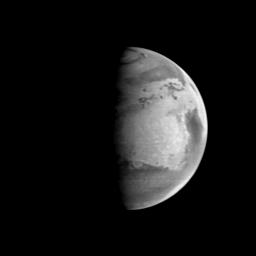
|
MGS Approach Image - 352.2° W Longitude
- Click the image above for a larger view
- Full-Res JPEG (512 x 512) (9.9 kB)
- Full-Res TIFF (512 x 512) (44.4 kB)
Caption:
The bright area at the center of this view of Mars taken by the MGS/MOC is called Arabia. It contains some of the brightest ground on Mars, thought to be especially deep or fresh dust deposits. Syrtis Major, the dark feature curving north-south near the center edge of the planet, is devoid of large amounts of dust, probably because sand moves for frequently there and kicks up the dust into the martian air where it can be transported away. The dark "splotches" near the middle top of the image are small sand dune fields trapped in the depressions of the Protonilus and Nilosyrtis "fretted terrain" (a zone of valleys formed by tectonic fracturing and subsequent erosion). In the lower portion of the image is Terra Sabaea, a heavily cratered area near regions where major dust storms occur. The light, semicircular indentation is the 480 km diameter crater Schiaparelli.
Background Info:
Malin Space Science Systems and the California Institute of Technology built the MOC using spare hardware from the Mars Observer mission. MSSS operates the camera from its facilities in San Diego, CA. The Jet Propulsion Laboratory operates the Mars Global Surveyor spacecraft with its industrial partner, Lockheed Martin Astronautics, from facilities in Pasadena, CA and Denver, CO.
Cataloging Keywords:
| Name | Value | Additional Values |
|---|---|---|
| Target | Mars | |
| System | ||
| Target Type | Planet | |
| Mission | Mars Global Surveyor (MGS) | |
| Instrument Host | Mars Global Surveyor | |
| Host Type | Orbiter | |
| Instrument | Mars Orbiter Camera (MOC) | |
| Detector | ||
| Extra Keywords | Atmosphere, Crater, Dune, Dust, Grayscale, Storm | |
| Acquisition Date | ||
| Release Date | 1997-09-10 | |
| Date in Caption | ||
| Image Credit | NASA/JPL/Malin Space Science Systems | |
| Source | photojournal.jpl.nasa.gov/catalog/PIA00931 | |
| Identifier | PIA00931 | |
